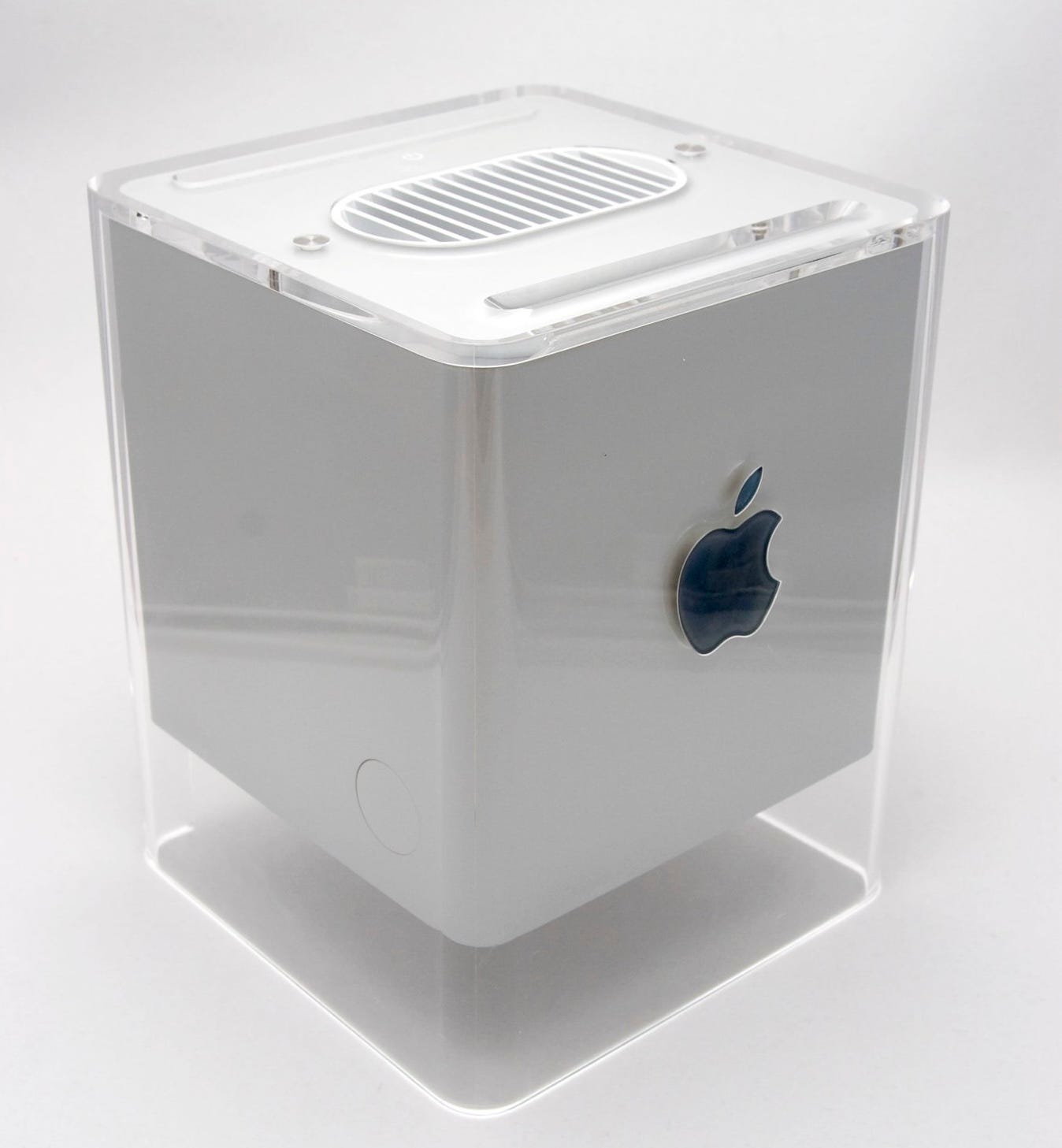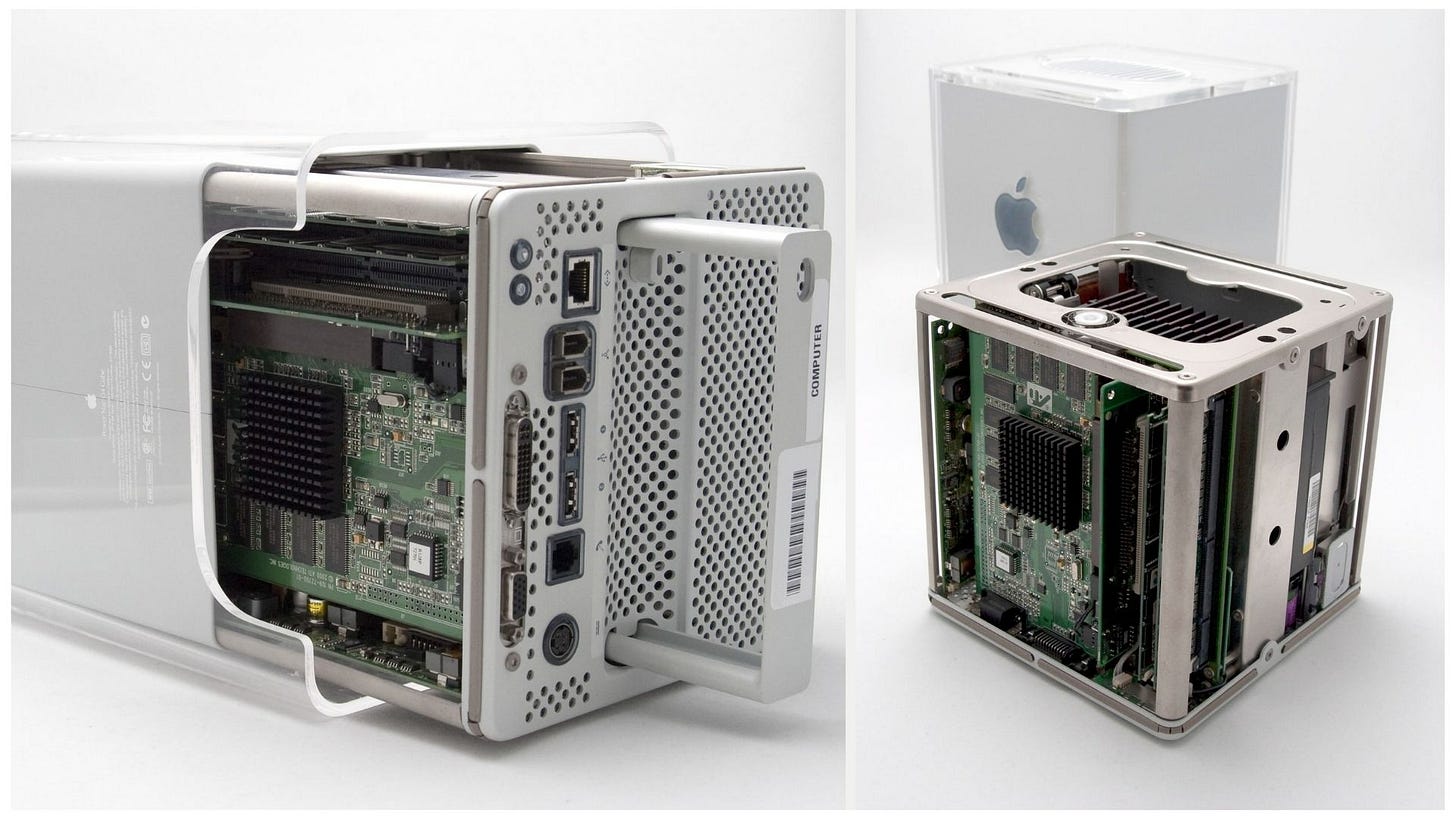When Mistakes Make the Work Better
Part 3: Creative failure isn’t the end—it’s the beginning of something bigger. Just ask Apple.
Do you recognize this Apple computer?
If you don’t, you are not alone.
Most people don’t.
It was a commercial flop. Launched in 2000, the Power Mac G4 Cube was sleek and minimalist — so striking that the Museum of Modern Art acquired one for its permanent collection.
And yet, it was dead on arrival.
It missed its sales targets, tanked Apple’s stock, and was pulled from shelves in under a year.
But before we dive into what happened—and how a product Tim Cook once called a spectacular failure helped shape Apple’s future—let’s return to something Dr. Ellen Langer shared with me on my podcast Business Artistry and I mentioned in part 1 and part 2 of this series on failure.
Langer, the pioneering Harvard psychologist turned painter, has spent decades studying how we respond to mistakes. And her research reframes the very nature of error:
“Every action—whether in business, art, or any field—begins with a decision. And every decision is rooted in uncertainty.”
We forget this. We make a choice, and then we treat it as fact. So when something goes wrong, we scramble to correct course—assuming the original plan was “right.”
But what if it wasn’t?
What if the so-called mistake was the moment we actually started paying attention?
Langer’s research suggests that products created through mistakes are often rated better than those produced without them. Why? Because mistakes force us out of autopilot. They demand presence. They turn creation into a conscious act.
In other words:
Mistakes don’t always disrupt the work. Sometimes, they awaken it.
The Apple Cube: A Beautiful Failure
In September 2000, under the leadership of Steve Jobs and Jony Ive, Apple released what might be its most elegant commercial failure: the Power Mac G4 Cube. An eight-inch glassy box—fanless, buttonless, and precision-machined to near perfection.
But from a business perspective? It was a disaster.
It had no clear audience. Too expensive for casual consumers. Too limited for professionals. Cosmetic flaws in early units hurt its appeal. Apple projected 450,000 units in sales. It sold just 150,000.
Partly because of the Cube’s poor performance, Apple’s revenue fell short by $180 million. Its stock dropped by 50% in a single day. By the end of 2000, it had lost more than 75% of its value. Less than a year after launch, production was suspended. Tim Cook would later call it "a spectacular failure.1"
For the business department, this was a flop. But for the design team—and for Apple's long-term creative evolution—the Cube was a turning point. What the MBAs might see as a misstep, the creatives saw as a step forward.
The Cube's influence showed up in three key ways:
Capabilities – It pushed Apple's limits in miniaturization and internal component design.
Manufacturing – It pioneered machining techniques that would define Apple's future products.
Culture – It signaled a shift in power: from engineering constraints to design ambition.
Internally, the Cube was admired for what it made possible. It marked a leap in Apple's ability to pack desktop power into laptop-sized spaces—critical for the dome-shaped iMac and later flat-screen models.
More importantly, it drove manufacturing innovation. "We did not accept standard molding practice in plastics," said engineer Gary Satzger in the book Jony Ive: The Genius Behind Apple's Greatest Products by Leander Kahney. "We started getting into machining plastic. On the Cube, the screw holes and vent holes were precision machined." That precision work became the blueprint for Apple's aluminum unibody designs, which I wrote about in the past—used in the MacBook, iPad, and beyond.
Culturally, the Cube helped shift Apple's internal hierarchy. Designers, once told by engineers what wasn't possible, began to lead. "The design team challenged everything—with plastics, metal, every material," Satzger said. The Cube became a symbol of form over function—but also a signal of what was to come.
It didn't just fail. It changed Apple.
The Cube's Enduring Legacy
Despite being a commercial failure, the Cube developed a passionate following. Macworld called it "a product ahead of its time," while John Gruber described it as a "worthy failure" that pushed computing toward being "smaller, quieter, and more attractive." CNET deemed it "an iconic example of millennium-era design."
After discontinuation, resellers commanded premium prices and enthusiasts created a robust modification community. Its futuristic appearance earned it screen time in Star Trek: Enterprise, 24, Absolutely Fabulous, and other shows as a prop representing advanced technology.
Most importantly, the Cube's specific innovations reshaped Apple's product line:
Its miniaturization techniques directly influenced the flat-panel iMac G4
Its precision machining became foundational for aluminum MacBooks and iPads
The Mac mini—one-fifth the Cube's size at just $499—fulfilled the original vision more successfully and remains in Apple's lineup today
Design elements persisted throughout Apple's evolution: capacitive touch reappeared in iPods and iPhones, the thermal design inspired later Mac Pros, and most visibly, the translucent cube shape was reborn as New York's iconic Fifth Avenue Apple Store
The Cube failed in the market but succeeded in shaping Apple's future. It didn't stall progress—it unlocked it.
Failure is Just the Beginning
Every time I think about failure, I’m reminded of a documentary I watched years ago—about a company I had never heard of, but that quietly changed my life - and the lives of millions around the world.
In the early 1990s, a Silicon Valley startup called General Magic set out to invent the future. Their vision? A handheld device that could connect everyone to everything—a kind of digital assistant you could carry in your pocket.
Sound familiar?
They were building the smartphone… a decade too early.
The company itself failed. Commercially, spectacularly. But the people didn’t. In fact, General Magic became one of the most powerful incubators in tech history. Its alumni went on to shape the digital age:
Tony Fadell – iPod; iPhone; Nest Thermostat
Megan Smith – Former U.S. Chief Technology Officer; former VP at Google; co-founder of The Malala Fund
Andy Hertzfeld – Part of the original Macintosh Team; co-creator of Google Circles
Kevin Lynch – Former CTO of Adobe; Creator of Dreamweaver, lead engineer on Apple Watch, and current VP of Technology at Apple
Pierre Omyidar – Founder of eBay
Phil Goldman – Co-founder of WebTV
Zarko Draganic – Founder of AltoCom (first modem company)
Andy Rubin – Founded Android
John Giannandrea – Former SVP Engineering; SVP Machine Learning and AI Strategy at Apple
Darin Adler – Former Head of Safari Browser
Many more spread across the top technology companies in Silicon Valley—quietly shaping the tools, platforms, and systems we now take for granted.
“Failure isn’t the end. Failure is actually just the beginning.”
In the film about General Magic, founder Marc Porat said the above. And maybe he was right.
Because General Magic didn’t just fail.
It fractured—and from those fragments,
the foundations of modern technology were laid.
The idea failed.
But the people didn’t.
They scattered like seeds.
And from that collapse came a forest.
That’s the kind of failure worth remembering.
Many of them went on to shape the tools, platforms, and systems we now take for granted—quietly building the future through what they learned when things fell apart.
But that’s not how most of us are taught to see failure.
In business, we’re conditioned to treat mistakes as inefficiencies. We’re taught to recover and move on.
But in creative work, mistakes are the movement.
They’re the moment something new begins to emerge.
That’s the mindset shift leaders must make.
Not to prevent every misstep.
But to recognize the signal in the noise.
To stay long enough to ask what’s hidden in the error.
To follow it somewhere better.
Because sometimes, the failed product becomes the foundation.
And sometimes, the mistake makes the work better.
If helping your teams navigate failure and uncertainty creatively is part of your mission, this is what I teach. In my keynote talks, I help leaders and organizations reframe mistakes—not as setbacks, but as catalysts for innovation. Curious to explore how this could help your team? Let’s talk: info [at] theartian.com
If you enjoy Business Artistry and think a friend or colleague would benefit from it, please share it with them. Just click on the button.
I’d love to hear from you—whether it’s your thoughts, suggestions, critiques, or even cool stories and ideas. Feel free to drop me a note, leave a comment, or send me a message.
Thanks
Nir
Just a heads-up: Some links might be Amazon affiliate links.
In Conversation with Apple CEO Tim Cook - The Oxford Foundry Launch




